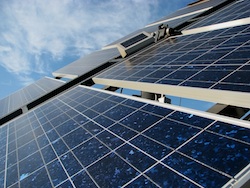 There has been a considerable amount of activity in the solar farm market over the past year, with developers rushing to acquire land for large scale arrays of photovoltaic panels. The green subsidies obtained for renewable energy projects under the government’s Feed-in-Tariff scheme (FIT) (with a maximum of 5 megawatts (MW)) and Renewables Obligation Certificates (ROCS) (with no maximum capacity) are gradually being reduced each year, creating this goldrush of opportunity. Perhaps more crucially, the UK’s electricity grid capacity is limited and the number of sites that can achieve low-cost grid connection are at a premium.
There has been a considerable amount of activity in the solar farm market over the past year, with developers rushing to acquire land for large scale arrays of photovoltaic panels. The green subsidies obtained for renewable energy projects under the government’s Feed-in-Tariff scheme (FIT) (with a maximum of 5 megawatts (MW)) and Renewables Obligation Certificates (ROCS) (with no maximum capacity) are gradually being reduced each year, creating this goldrush of opportunity. Perhaps more crucially, the UK’s electricity grid capacity is limited and the number of sites that can achieve low-cost grid connection are at a premium.
Investment
The schemes generally involve a specialist company bearing the costs, undertaking the preparatory work including a site and environmental impact survey, planning application and obligations, grid connection, construction and management under a lease from a landowner, in return for rent and/or supply of free electricity or electricity at a reduced cost.
The capital outlay can be prohibitive to farmers and landowners, running to tens of thousands of pounds for sites of between 50 to over 100 acres sufficient to generate over 6MW, but the rental returns are very attractive. Rents can be as much as £1,000 - £1,500 per acre compared to farming rents of e.g. £100-150 per acre, for little risk. Rent can be linked to the proportion of income generated by the panels, and/or a supply of free or reduced cost electricity
In order to see good returns, solar farms tie up the land for up to 25-30 years, so landowners need to consider the long term impact on their businesses. However solar panels can leave room for other activity around the base of the panels for sheep grazing, environmental projects such as wild flower planting, bird nesting etc, and they can make use of less productive, lower grade agricultural land.
Planning Considerations
Suitable sites do not have to be south facing or in areas of most regular sunshine, but they do need open areas free from shadow, and reasonable access for construction, maintenance, and reasonable connection to the electricity grid. Solar arrays are generally less obtrusive than other energy developments like wind turbines. They are relatively quick to install, with shallow foundations, are silent and require minimal maintenance, so that site traffic is much reduced following construction. Despite problems with local opposition, Government policy actively encourages solar farms. Developers are not likely to invest large upfront costs without having considered the potential success of an application. The solar industry is purportedly committed to, among other things, minimising the visual impact by screening, likely to be part of their planning application and eventual obligations.
Legal Issues
Developers will commonly approach a landowner with a proposed set of terms and ask for a period of exclusivity to prevent competition from other developers. They may want an option to take a lease, which will only complete when the planning consents are obtained and grid connections accredited. Unless accreditation is secured with the district network operator then the developer will not be able to connect and operate the site. Accreditation depends on the capacity available and whether connection will overload or cause damage to the network or whether it will strengthen it.
Once the option is signed, the landowner is bound by obligations during the option period, commonly two to three years and, if exercised, the landowner will then be bound by the terms of the lease. The terms can be complex and landowners are strongly advised not to sign anything until the terms have been negotiated by professional land agents, and the documents reviewed and approved by solicitors who have experience in this market. For instance the developer may insist on restrictive covenants, which would prevent the landlord owner from developing other land or buildings for other renewable projects or in a way that could interfere with the viability of the solar development.
Also the option should require the developer actively to seek planning consent within a time frame to prevent them holding land speculatively.
There may be problems with surrendering agricultural tenancies which require a notice period of at least one year, and possibly compensation claims for lost crop and tax issues to factor in to the agreements.
Landowners should be aware that if the energy market changes or if the solar company fails, the rental income could come to an end and in the worst case the landowners could be left with a solar farm that is not viable and land that needs to be put back to agricultural use. One way of reducing the risk of reinstatement costs is for the developer to provide an agreed sum of money on deposit sufficient to cover costs of site clearance and returning the land to agricultural use, known as a decommissioning bond.
Solar arrays are only part of the renewable energy technology currently available. While they continue to offer good returns, they represent a good return on land investment for developers and landowners. However they will be a limited by rising infrastructure costs, such as the effect of the restriction on importing cheap solar panels from China, and potential exhaustion of grid connection capacity, which could affect the viability of potential new installations in the future.
About the author
 Sue Lister is a Senior Associate at Thomson Snell & Passmore
Sue Lister is a Senior Associate at Thomson Snell & Passmore
Have you any commercial property events you'd like to tell us about? It could be networking, exhibitions, seminars, industry lunches or sporting fixtures. We will list them for free. Just email newsdesk@propnews.co.uk with the following details: Event name, date, time, venue, cost, booking info and a brief description of the event.
To list your property job vacancies on Property News. Email: richenda@propnews.co.uk.